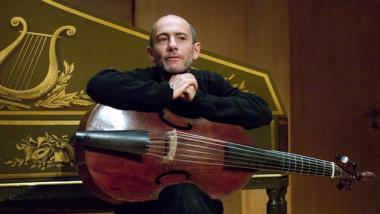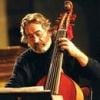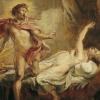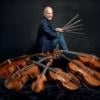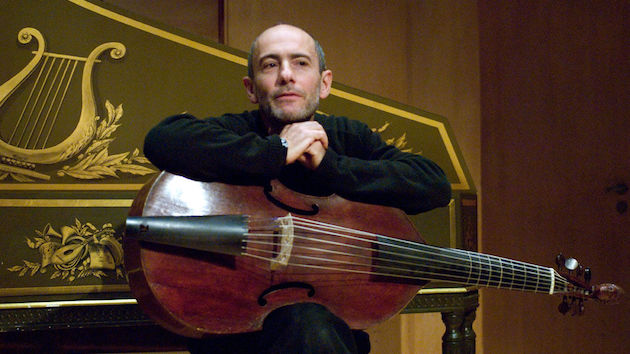
The music of the French Baroque is something of an oxymoron. It was written, largely, for the glittering courts of Versailles and Paris, to delight Europe’s most overtly autocratic and convention-bound monarch — Louis XIV, the Roi Soleil [“Sun King”]. Such music could well have been as stiff and class-conscious as court life. But composers like Marin Marais, the son of a shoemaker, and François Couperin, a kid from the country, not only found high status at the court but also left us music that transcends its royalist and conservative origins.
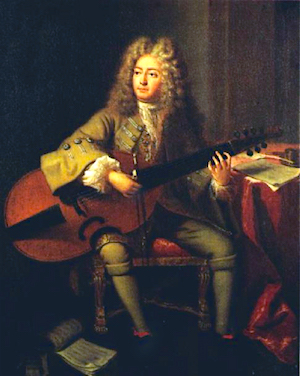
That music — emotionally and technically daring, even revolutionary — was the center of Friday evening’s concert by Paolo Pandolfo and his ensemble: Paolo Pandolfo and Amélie Chemin, viols; Markus Hünninger, harpsichord; and Thomas Boysen, theorbo and Baroque guitar.
Paolo Pandolfo has been known for decades as one of the finest players of the viol (or viola da gamba), the cello-sized instrument on which Marais himself was a star in his day. Pandolfo’s recordings of the solo viol repertoire — to which he has daringly added the cello suites of J. S. Bach — are well-known to early music performers and listeners. More recently, he has turned to studying and performing the riches of French chamber music of the late 17th century.
Four chamber pieces by Marais showed an astoundingly rich variety of sound and affect. Two suites bookended the concert, the first in a somber D minor and the last in a contrasting sprightly G major. Like all Baroque suites, these are built upon the standard dance forms of the day, such as the allemande, courante, sarabande, and gigue. The Pandolfo ensemble at once respected the conventions of those forms and explored Marais’s inventive uses of them. Phrases were never simply repeated, but were varied in color and emotion, The fluid sound of the viols — rich, smooth, and introspective — were contrasted with the rhythmic, social energy of the theorbo and guitar; the harpsichordist improvised delicate, higher-pitched right-hand accompaniments to lighten the often dusky feel of the low-pitched viols.
The most moving piece on the program was Marais’s epitaph (or tombeau) for a talented amateur musician, one M. Méliton. The passage from life to death has rarely been shown with such dignified grief, the music full of a restrained but ever-present tension; balanced and structured but always close to the edge of rawer emotions.
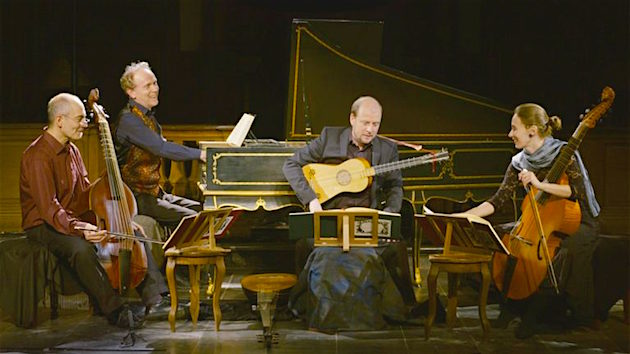
In a set of variations, Pandolfo himself showed his incomparable technique on the viol, with swirling and apparently effortless roulades above a steady ground bass—all without sacrificing his essential musicianship. Not the least of his skills is a variety in tone color, ranging from a rich intensity to the slightest of whispers, a focused sotto voce that draws the listener into the heart of the music. Fellow viol player Amélie Chemin matched and supported Pandolfo’s virtuosity, especially in a beautiful echo duet variation. Together, they made each variation seem utterly fresh, as if improvised on the spot.
Between the Marais pieces in the first half of the concert, Harpsichordist Markus Hünninger presented two solo pieces by Couperin, Les Idées Heureuses (Pleasant ideas) and Les Papillons (Butterflies). The thoughtful quality of the first of these embued the potential flightiness of the second with an unexpected seriousness. A Prelude and Chaconne by Robert De Visée was lutenist Boysen’s solo, full of cascading scales down the octave and ending with an exquisitely pulsating heartbeat in the inner voices.
Bringing the Paolo Pandolfo Ensemble to the area was the brainchild of an admirable collaboration between two small East Bay presenting organizations, Barefooot Chamber Concerts and Music Sources. Bravo to them for booking this extraordinary and rarely-heard group and finding an acoustically perfect venue for them, the lovely church of St. Mary Magdalen in Berkeley.

